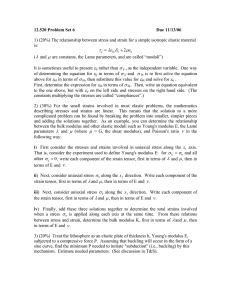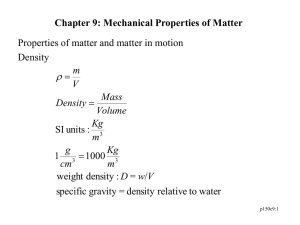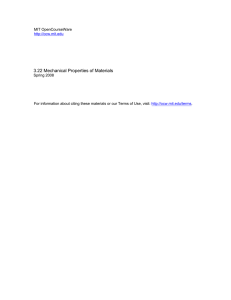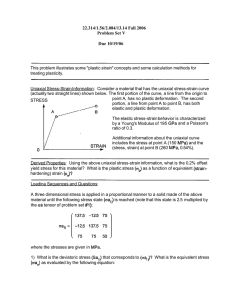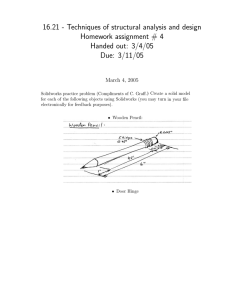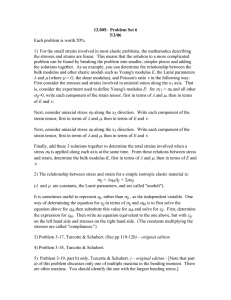3.22 Mechanical Properties of Materials
advertisement
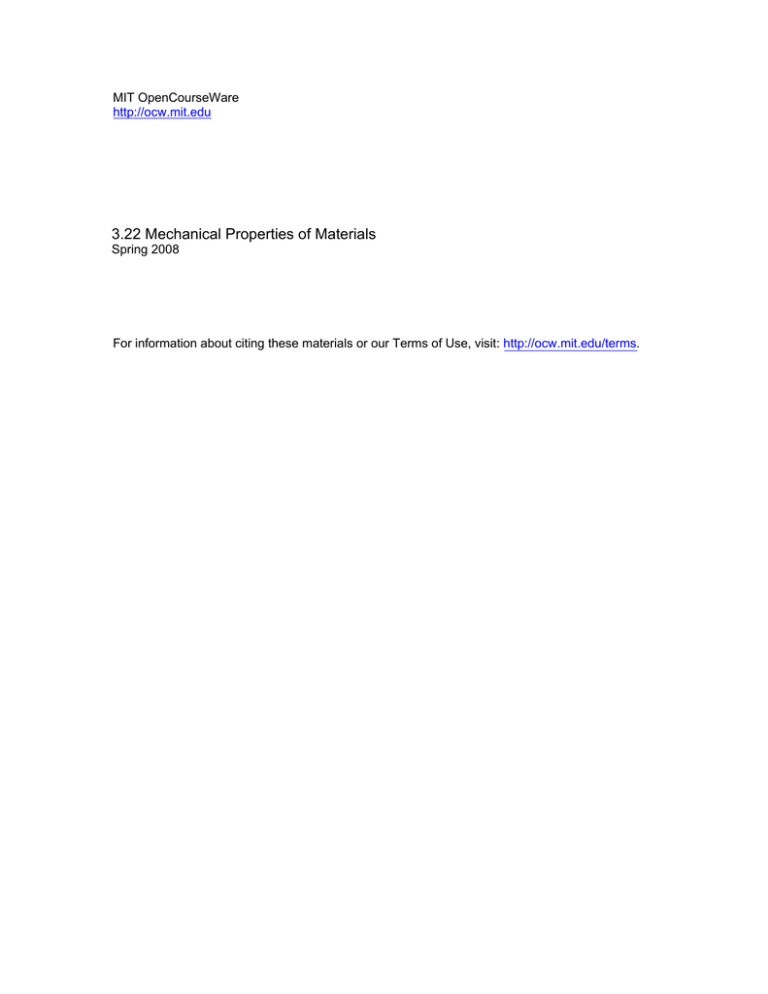
MIT OpenCourseWare http://ocw.mit.edu 3.22 Mechanical Properties of Materials Spring 2008 For information about citing these materials or our Terms of Use, visit: http://ocw.mit.edu/terms. 3.22 Mechanical Behavior of Materials Spring 2008 Quiz 1 • • • • • Show all your work on the sheets included in this stapled document. Use partial credit to your advantage. If you're running short on time, solve algebraically and then solve numerically (plugging in numbers) later. If there is not much space given for you to provide an answer, I want you to be brief. You may not need to use all the information given (e.g., dimensions) to reach your conclusions. Enjoy your almonds before getting started! Almonds reduce low-density lipoprotein cholesterol, decrease oxidative damage to tissues, and improve indices of cardiovascular disease associated with stress. NAME (PRINTED): I agree that this document represents my own independent work on this quiz, using only my own brain, my allowed crib sheet of equations and notes, and my pen / pencil / calculator / protractor / compass / ruler / sliderule. SIGNATURE: 1. (a) Draw a free body diagram of the horizontal element of the crane (the horizontal span in Fig. 1a), treating it as a beam and indicating all known and unknown applied / reaction forces. You will need to make assumptions about how the crane is connected to the real world, and these should be briefly justified. (b) Consider the hook-end of the crane's horizontal element (Fig. 1b), now loaded by the weight of the steel I-beam. Can member AC be made from a thin steel cable (essentially an elastic rope)? Here, you're considering the elements of the truss explicitly, so their weight as a whole beam structure (i.e., q) can be neglected. Explain your answer fully. 2. (a) We know σij and εij can be expressed as quadrics, three-dimensional surfaces defined by a cubic polynomial equation of σp or εp. Explain concisely, but fully and accurately, what this fact immediately implies about tensorial stress and strain. (b) You are asked to confirm that your thesis advisor's following calculations are correct. (He is an expert in electromagnetic material behavior, and often leans on you for help with mechanical behavior.) He has fabricated a metal interconnect line from vapor deposited Cu, and x-ray diffraction has indicated that all the grains in the polycrystalline line are oriented with all grain boundaries inclined 45o with respect to the Si substrate. When the device is heated, your advisor expects the material at the center of the line to expand uniformly in all directions (neglecting the edge effects at the substrate and free surface). He therefore predicts that this means the line will probably fail because the grains will shear apart at their boundaries. Respectfully explain to him why this prediction is incorrect, even if we allow for neglect of edge effects. (c) He then asks you to check a stress transformation onto the grain boundary planes, calculated by your labmate, as shown below. Is this transformation correct? (You do not need to repeat the transformation to answer this.) 3. A polycrystalline, pure silver (Ag) slug is placed in a rigid die as shown, to create custom jewelry. Uniaxial compressive stress σzz = σo is applied normal to the slug face. We will assume the die is well lubricated at the material/die interface. (a) Determine the orthogonal normal stresses in terms of applied stress and appropriate elastic constants of the material. Here, note that there are constrained and free surfaces created by the geometry of the die, such that the applied stress is uniaxial but the stress state in the material is more complex. (b) Determine the axial strain εzz in terms of applied stress and appropriate elastic constants of the material. (c) This material will deform under conditions of high shear stress. Predict the orientation and magnitude of maximum shear stress resulting from this applied stress state with respect to the given axis-set, being sure to indicate the plane (xy, xz, or yz) on which this maximum shear stress occurs. 4. When discussing the atomistic basis of linear elastic deformation, we considered an approximate derivation that related the Young's elastic modulus E to the internal energy U as a function of strain ε and then a more rigorous definition in terms of U(r). (a) In contrast, for a rubber elastic / hyperelastic material, we only discussed the rigorous atomistic basis in terms of a spring constant k. Briefly explain the difference between E and k in terms of units and properties of the material. (b) Now provide the approximate derivation of the following elastic constants in terms of thermodynamic state variables U and S and the applied strain εij: K, the bulk elastic modulus indicating resistance to dilatation (volumetric strain change) under an applied stress σij = σii ; and E, the Young's elastic modulus. Give your solution in terms of K (U, S , V, ε) and E(U, S , V, ε), where V is the unit volume of material. (c) For an elastomer, state whether you expect K to be large or small in magnitude; and E to be large or small in magnitude. (d)The Poisson's ratio of a material can be expressed in terms of K, E and G. For example, ν = ½ - 1/6(E/K). Based on this relation, what is the expected lateral strain resulting from an axial compressive strain of 100% imposed on an elastomer? (e) Besides the cis-isoprene latex example discussed in class, give the name of at least one other actual material that is expected to exhibit elastomeric behavior at room temperature. ENJOY YOUR WEEKEND, WITH ONE EXTRA HOUR BROUGHT TO YOU BY HOOKE (clocks ''spring'' forward on Sunday)!

